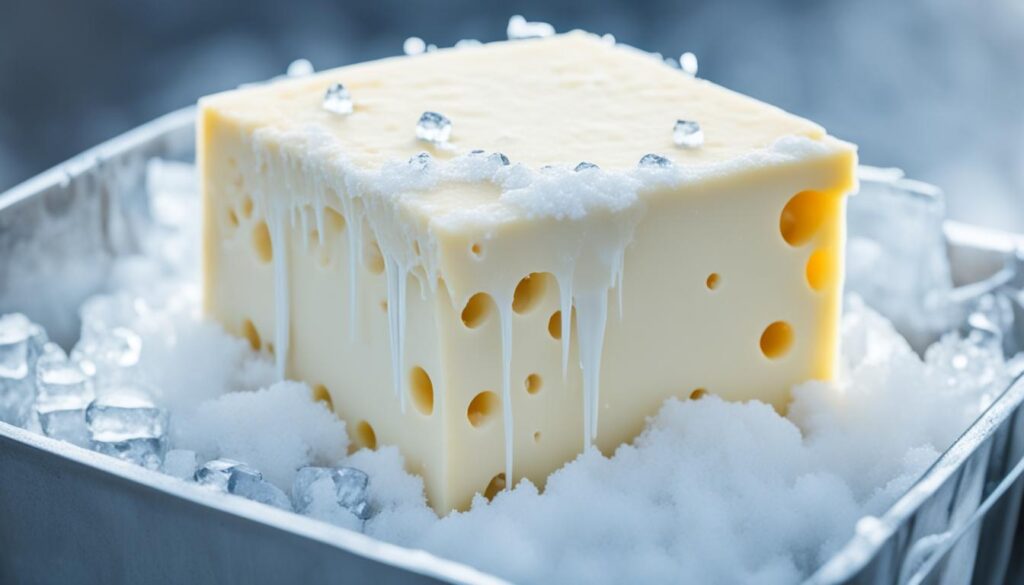Properly storing and serving cheese is essential for maintaining its peak flavor and texture. At our cheese storage serving tips, we understand the importance of cheese aging techniques and best cheese storage practices in preserving cheese freshness. By following these expert tips, you can ensure that your cheeses stay fresh and delicious.
One of the key factors in enhancing the flavors and textures of cheese is serving it at the ideal temperature. All cheeses should be served at room temperature to bring out their unique flavors and textures. Cold cheese tends to lose its full potential in taste. It is advisable to allow your cheese to rest at room temperature for at least one hour before serving.
When it comes to proper cheese storage techniques, it’s important to consider using suitable cheese storage containers or wrapping the cheese in waxed or parchment paper. This allows the cheese to breathe while preventing it from drying out. Storing cheese in the coolest and darkest part of your refrigerator, such as the vegetable/fruit bin, helps maintain its flavor and texture. Maintaining a humidity level of between 35 and 45 degrees Fahrenheit not only keeps the cheese fresh but also preserves its texture and flavor.
For maximum freshness, choose porous materials like cheese paper, parchment paper, or breathable plastic wrap to wrap your cheese. These materials help retain the cheese’s moisture content and prevent it from drying out. Avoid leaving unwrapped or partially wrapped cheese in the fridge to avoid it from becoming dry and picking up other flavors.
While freezing cheese is not recommended for fresh and high-moisture cheeses due to significant textural changes and flavor loss, harder, drier cheeses like Parmesan can be successfully frozen. Remember to wrap the cheese properly in paper, then plastic, and finish with tin foil to prevent odor absorption.
When it comes to slicing and dicing cheese for optimal flavor, it’s crucial to maintain the original wedge shape of the cheese. Each slice should be cut along the edge of the wedge to ensure you savor its full range of flavors, from the center to the rind. Avoid dicing or pre-slicing the cheese, as it can lead to moisture loss and impact the overall taste.
Avoid pre-grated and crumbled cheeses, as they tend to have a larger surface area exposed to air, resulting in rapid flavor and texture loss. Invest in a good cheese grater and a whole block of cheese for the best flavor and texture. Grate the cheese as needed to maximize freshness.
Serving Cheese at the Ideal Temperature
All cheeses should be served at room temperature to enhance their flavors and textures. When cheese is cold, it becomes harder to taste its full range of flavors and appreciate its unique texture. To achieve the best taste experience, let your cheese rest at room temperature for at least one hour before serving.
Allowing cheese to reach room temperature allows its flavors to fully develop. This is especially important for artisanal and aged cheeses, as their complex flavors can be masked when served cold. When cheese is cold, the fats within it solidify, altering its mouthfeel and texture. Room temperature cheese, on the other hand, has a smoother and creamier texture, allowing you to fully savor its richness.
By serving cheese at room temperature, you can fully appreciate the nuances of its flavors. Cheeses like Brie and Camembert, when served cold, may seem bland and lacking in taste. However, when allowed to warm up, their flavors become more pronounced, offering a delightful experience to your taste buds. The same holds true for other varieties such as Cheddar, Gouda, and Blue cheese.
When preparing a cheese platter, take your cheese out of the refrigerator at least one hour before serving to give it enough time to reach room temperature. This will ensure that your guests enjoy the cheese at its best. If you’re hosting a gathering, consider setting out a few different types of cheese and allowing them to warm up simultaneously on the cheeseboard.
Remember, proper cheese serving temperature is crucial to fully appreciate the flavors and textures. Take the time to let your cheese rest at room temperature before indulging, and you’ll be rewarded with a delicious and memorable culinary experience.
| Cheese Type | Ideal Serving Temperature |
|---|---|
| Brie | 60-65°F (15-18°C) |
| Camembert | 60-65°F (15-18°C) |
| Cheddar | 65-70°F (18-21°C) |
| Gouda | 65-70°F (18-21°C) |
| Blue Cheese | 60-65°F (15-18°C) |
Why Room Temperature Matters
Serving cheese at room temperature allows the flavors to bloom and the texture to become more supple. When cheese is too cold, the flavors are muted and the texture can be rubbery or crumbly. Allowing the cheese to warm up brings out its true character and makes it more enjoyable to savor.
Proper Cheese Storage Techniques
Properly storing your cheese is crucial for maintaining its freshness and flavor. By following these cheese storage methods and humidity suggestions, you can ensure that your cheese stays in optimal condition.
Choosing the Right Cheese Storage Containers
Investing in quality cheese storage containers is a wise decision. These containers help maintain the ideal environment for cheese by allowing it to breathe while preventing excessive moisture loss. Look for containers made of materials like plastic or glass that provide airtight seals.
Wrapping Cheese in Wax or Parchment Paper
Another effective method for cheese storage is wrapping it in waxed or parchment paper. These breathable materials promote air circulation, keeping the cheese moist without causing excessive humidity. Avoid using plastic wrap or aluminum foil, as they can trap moisture and affect the cheese’s quality.
Refrigerator Placement for Cheese Storage
When storing cheese in the refrigerator, it’s essential to find the right spot. The coolest and darkest part of the refrigerator, such as the vegetable or fruit bin, is ideal for cheese storage. This area helps maintain a consistent temperature and minimizes exposure to light.
Maintaining the Perfect Humidity Levels
Humidity plays a crucial role in cheese storage. Aim for a humidity range between 35% and 45% to preserve the cheese’s texture and flavor. To achieve this, you can use a hygrometer, a device that measures humidity levels, or place a small dish of water in the refrigerator to create a humid environment.
By implementing these cheese storage techniques, you can ensure that your cheese retains its quality and flavor for extended periods. Now, let’s move on to the next section for tips on properly wrapping cheese to maximize its freshness.

Wrapping Cheese for Maximum Freshness
Proper cheese wrapping is crucial for maintaining its freshness and flavor. When it comes to wrapping cheese, there are a few important guidelines to follow to ensure the best results.
Choosing the Right Materials
Opt for porous materials like cheese paper, parchment paper, or breathable plastic wrap specifically designed for cheese. These materials allow the cheese to breathe while preventing excessive moisture loss. Avoid using regular plastic wrap or foil, as they can suffocate the cheese and lead to spoilage.
TIP: Look for cheese paper, which is specially coated to create a microclimate around the cheese, preserving its moisture and flavor.
The Wrapping Process
Start by laying your cheese on a clean, dry surface. If the cheese came with its own original packaging, assess its condition. If the packaging is suitable and intact, you can continue using it. Otherwise, proceed with wrapping the cheese yourself.
Cut a sheet of your chosen wrapping material that is large enough to fully enclose the cheese. Place the cheese in the center of the paper or wrap, making sure there is enough material to cover the entire surface.
Next, fold the wrapping material over the cheese, pressing gently to ensure a snug fit. Make sure to cover all sides completely, creating a protective barrier against air and light.
TIP: Secure the wrapping with a piece of tape or a rubber band to keep it in place.
Storing the Wrapped Cheese
Once your cheese is wrapped, it’s essential to store it properly to maintain its freshness. Place the wrapped cheese in the refrigerator’s vegetable/fruit bin, which is the coolest and darkest part of the fridge.
Keep in mind that cheese is sensitive to moisture, so it’s crucial to maintain its ideal humidity level. Aim for a humidity range between 35% and 45% to prevent it from drying out or becoming too moist. If your refrigerator doesn’t have a humidity control feature, consider storing the wrapped cheese in a separate container with a humidity regulator.
Avoiding Unwrapped or Partially Wrapped Cheese
Leaving cheese unwrapped or partially wrapped in the refrigerator is a recipe for disaster. Unwrapped cheese is vulnerable to drying out, developing a tough texture, and absorbing other flavors and odors from the fridge.
Always take the extra step to fully wrap your cheese or transfer it to an airtight container if it’s already cut. This simple precaution will go a long way in preserving the cheese’s freshness and ensuring that it showcases its best flavors.
By following these proper cheese wrapping techniques, you can extend the shelf life of your cheese, prevent flavor degradation, and enjoy consistently delicious results.
Avoid Freezing Fresh and High-Moisture Cheeses
When it comes to cheese storage, freezing is not the ideal solution for fresh and high-moisture cheeses. These types of cheeses are more delicate and may experience significant textural changes and loss of flavor when frozen. However, harder, drier cheeses like Parmesan can be successfully frozen without compromising their quality.
If you find yourself with excess fresh or high-moisture cheese that you cannot consume before it spoils, consider other methods of preserving their freshness. Here are some tips to help you store your cheeses properly:
- Wrap the cheese properly: Use waxed or parchment paper to wrap the cheese. This allows it to breathe while protecting it from drying out.
- Avoid plastic wrap: While plastic wrap may seem convenient, it can create a suffocating environment for the cheese, leading to moisture retention and potential off-flavors.
- Add an additional layer of protection: After wrapping the cheese in paper, place it in a plastic bag or airtight container to provide an extra barrier against moisture and odors.
- Use tin foil as the final layer: To further prevent odor absorption, wrap the cheese-covered container or bag in tin foil before storing it in the refrigerator.
By following these cheese storage tips, you can help keep your fresh and high-moisture cheeses in optimal condition for longer periods, avoiding the need to freeze them and sacrificing their delicate flavors and textures.
“Freezing fresh and high-moisture cheeses can result in significant textural changes and flavor loss.”
For reference, here is a table summarizing the cheese types that should and should not be frozen:
| Cheese Type | Freeze? |
|---|---|
| Fresh and high-moisture cheeses (e.g., Mozzarella, Brie, Feta) | No |
| Hard and dry cheeses (e.g., Parmesan, Cheddar, Gouda) | Yes |
Expert Tip:
Before freezing any cheese, it’s essential to consider the texture and moisture content. Softer, more delicate cheeses are best enjoyed fresh, while harder cheeses are more suitable for freezing. If you’re unsure whether a particular cheese can be frozen, consult with a cheesemonger or refer to the cheese producer’s recommendations.

Slicing and Dicing Cheese for Optimal Flavor
When it comes to serving a cheese platter, proper cheese cutting etiquette is essential to ensure that you and your guests can fully savor the flavors of each cheese. One important aspect of the cheese cutting process is maintaining the original wedge shape of the cheese.
Each slice should be cut along the edge of the wedge, allowing you to experience the full range of flavors from the center of the cheese to the rind. By following this technique, you can appreciate the subtle nuances and complexities that each cheese has to offer.
Avoid dicing or pre-slicing the cheese, as these methods can lead to moisture loss and compromise the overall taste. By keeping the cheese in its original wedge form, you preserve its integrity and ensure that it retains its optimal flavor.
Properly slicing cheese not only enhances the taste experience but also adds an aesthetic appeal to your cheese platter. Your guests will appreciate the effort put into maintaining the cheese’s shape, and it will make for an impressive presentation.
| Cheese Cutting Etiquette Tips |
|---|
| 1. Use a sharp cheese knife to maintain clean, smooth cuts. |
| 2. Slice along the edge of the cheese wedge to preserve its shape. |
| 3. Avoid dicing or pre-slicing the cheese to prevent moisture loss. |
| 4. Allow each guest to cut their own slices to suit their preferences. |
| 5. Serve cheese with suitable accompaniments, such as crackers or fruit. |
Avoid Pre-Grated and Crumbled Cheeses
When it comes to enjoying the best flavor and texture in your cheese, it’s important to avoid pre-grated and pre-crumbled options. These convenient choices may seem tempting, but they can lead to a loss of both flavor and texture due to increased exposure of the cheese surface area to air.
Investing in a good quality cheese grater and opting for a whole block of cheese can make a noticeable difference in your culinary experience. By grating the cheese as needed, you can ensure maximum freshness and preserve the optimal flavor and texture of your cheese.
Pre-grated and pre-crumbled cheeses often have a larger surface area, which can result in rapid flavor and texture deterioration. When the cheese is grated or crumbled, more of it is in contact with the air, causing it to lose its original characteristics more quickly. To retain the best quality, consider purchasing a block of cheese and grating it yourself just before use.
By following this proper cheese grating technique, you can savor the true flavors and textures of different cheese varieties, enhancing your overall culinary experience.
